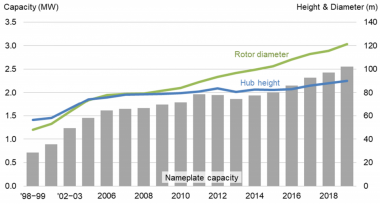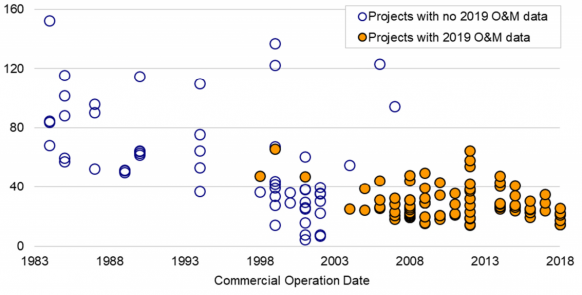Wind inspectors deploy nimble drones, crawlers as blades grow
As turbine dimensions increase, wind operators are using advances in remote technology and scanning to increase the speed and scope of blade inspections.

Related Articles
Ageing wind fleets and growing turbine capacities are increasing the importance of blade inspections.
As power market competition intensifies, wind operators are under pressure to maximise the output and lifespans of turbine assets.
Growing turbine capacities are raising efficiency levels but larger blades mean greater areas of materials must be inspected.
US average turbine capacity, dimensions by year
(Click image to enlarge)
Source: Lawrence Berkeley Lab, August 2020.
Some blades now measure up to 90 metres in length and higher replacement costs mean operators are keener than ever to prolong their lifespans, Dennis Roach, Senior Scientist at Sandia National Laboratories, told Reuters Events.
“It’s too expensive to keep a spare set of blades at wind farms and too expensive to replace them,” he said.
Operators may also want to inspect blades more often as they approach end of design life, typically 20 years, he noted.
Some 65 GW of European wind capacity will reach 20 years of operation by 2028 and 42 GW could represent commercially-viable lifetime extension projects, Wood Mackenzie said in a report published in September 2019. IHS Markit predicts the average age of US wind turbines will rise from seven years in 2018 to 14 years in 2030.
Blades could potentially operate far longer than their design life, but there is little experience on newer, longer blades, Kim Branner, Senior Scientist at the Technical University of Denmark (DTU), said.
“We are getting better at sorting the problems out,” Branner said. “But the gains are roughly cancelled out by the push to go closer to the design limits for newer and longer blades, which may lead to new problems.”
Damage risks
Blades can incur in-service damage from environmental impacts, such as lightning strikes, extreme rain, hail, ice, sand, dust, or bird collisions.
Millions of revolutions and, in many cases, repeated starts and stops, can cause leading-edge erosion and heating and cooling issues.
US average wind O&M costs by installation year ($/kW-yr)
(Click image to enlarge)
Source: Lawrence Berkeley Lab, August 2020.
Longer blades can also endure aero-elastic resonances at lower wind speeds that are difficult to model and can lead to mid-radius cracks, Brandon Fitchett, Renewable Energy R&D Senior Project Manager at the Electric Power Research Institute (EPRI), told Reuters Events.
“Without early detection and a serial change in operations to avoid resonance conditions, this has resulted in many complete blade losses totalling millions of dollars,” he said.
Remote inspections
Despite continuing technology innovations, operators still typically use hanging platforms or rope systems to inspect blades as these are not greatly restricted by hub height. Some operators have turned to innovative ground-based vehicles that use telescopic platforms to lift technicians to greater heights, Fitchett said.
An increasing number of owners are also using drones, particularly for large wind farms.
Recent improvements in drone technology include automated flight controls, lighter batteries and image stabilisation technologies, that make “truly high-quality visual blade inspections possible from a small drone," Fitchett said.
Larger operators, OEMs and specialist O&M suppliers are also starting to use crawling robots to inspect blades.
“People have likened [the robot] to a Swiss army knife, with multiple heads that can be switched out and deployed,” Roach said.
Soon, advanced phased array ultrasonics will allow operators to perform deeper, more detailed inspections of blade materials, Roach added.
“They are not in the field yet but it’s heading that way,” he said.
Faster insights
New technologies like drones will also allow operators to optimise image recognition software and data analytics to increase detection speeds and generate pro-active insights.
A.I. can be used to analyse images collected by robots and drones to learn over time as fault information is fed back into the system.
Data pools are growing as wind fleets expand and going forward the increasing use of sensors will provide even greater data flows.
EPRI is building a database of records for blades and other major components, including reliability projections, damage categorization and correlation.
“With enough historical data, an empirical approach may statistically tell what is most likely to be beneath the surface of a particular defect if identified visually," Fitchett said.
EPRI recently completed a study of visual blade damage assessments and will soon publish the results.
Zero damage
A full examination of blade defects still requires "destructive" methods, but going forward less invasive methods may be possible.
This could be transformative for operators and service companies, allowing ground-based detection and quantification of a sub-surface defect.
Techniques include ultrasound and less well-known approaches such as shearography, thermography, and the use of microwaves, Fitchett said.
“There is experimental non-destructive evaluation work ongoing in this area, but the quantification challenge remains," he said.
Innovative new blade materials could also impact blade inspection methods. Turbine suppliers are now using carbon graphite in certain blade layers and research teams are testing the use of natural materials such as hemp and bamboo, Branner said.
Going forward, suppliers will be under increasing pressure to minimise the carbon footprint of blades while also maximising performance.
Reporting by Neil Ford
Editing by Robin Sayles


